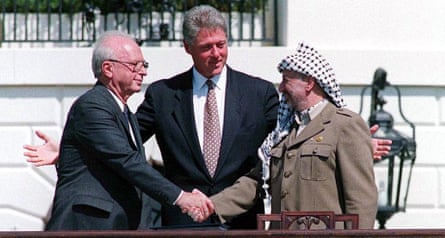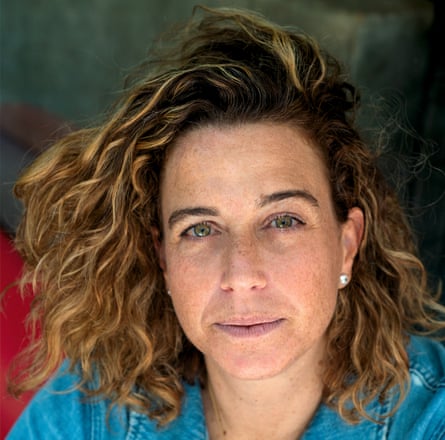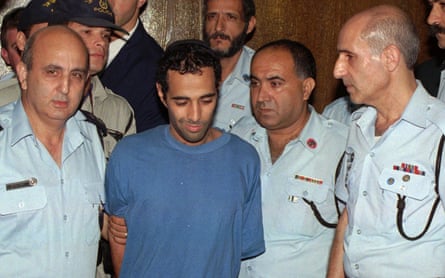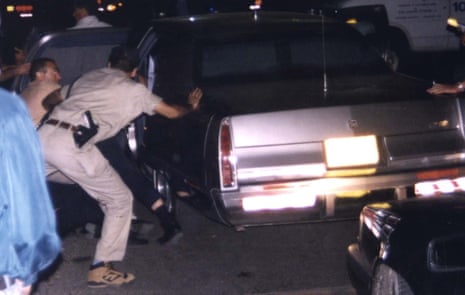They wanted him to wear a bulletproof vest, but he wouldn’t hear of it. Afterwards, they wished they’d pushed him harder – they should have insisted – but he was the prime minister and his mind was made up. He refused to believe a fellow citizen might pose a mortal threat.
And so a quarter of a century ago, on the night of 4 November 1995, Yitzhak Rabin stood before a vast and grateful crowd in Tel Aviv at a peace rally, protected by nothing more than a jacket, tie and white cotton shirt. The size of the rally had surprised him: he was a shy man, awkward with attention, and he had doubted that thousands of Israelis would come out to show support for him and his attempt to make peace with the Palestinians. He told aides he feared the city’s central plaza – not yet called Rabin Square – would be empty.
Instead the place was brimming with more than 100,000 people, many of them young, and the atmosphere, they said, was glorious. Rabin gave a speech insisting Israelis were ready for peace, urging them to overcome their fears, let go of the past, and finally forge an accord with their neighbours.
The emotional climax came when the veteran folk singer Miri Aloni performed her signature anthem, Shir LaShalom (A Song For Peace). Sandwiched between Rabin and the other politicians, the singer beckoned the prime minister to join in, putting a microphone to his mouth. Reluctantly, all but blushing, he mumbled along in his rumbling bass voice, reading the lyrics from a sheet someone had given him. He got through it, tucked the text into a pocket and left the stage, walking the few steps down to a waiting car. He had a parting message for the crowd, including the teenagers jumping into the fountains with their Peace Now banners: “Let’s not just sing about peace – let’s make peace.” They cheered for the man old enough to be their grandfather.
But it wasn’t just his car that was waiting backstage. Yigal Amir, a 25-year-old Israeli Jew, fervent in his faith and his nationalism, stepped out of the shadows and calmly shot the prime minister twice in quick succession. An hour and a half later, Rabin would be pronounced dead. Within a few months, his government would go the same way, taking the prospect of a lasting peace between Palestinians and Israelis along with it.
To this day, the killing of Yitzhak Rabin by a man determined to halt the Middle East peace process remains that rare thing: an act of political violence that wholly achieved its aim. Judged by the goal it set itself, it is surely the most successful assassination in history. But it is also a story centred on an extraordinary man who had made the journey from warrior to would-be peacemaker – a story of the family who loved him, the bodyguards and doctors who tried to save him, and the rivals who jostled to replace him. The intense, desperate and chaotic 90 minutes that followed the shooting both revealed a nation riven by a lethal divide and changed that nation for ever. Now those most closely involved, several speaking for the first time to a non-Israeli publication, are ready to give the most intimate account yet of what happened on the night two bullets altered the destiny of two nations.
The road to Yitzhak Rabin’s assassination began in Oslo. It was there that two teams of negotiators, Palestinian and Israeli, met in secret, gradually forging the Oslo accords, sealed in September 1993 by a handshake on the White House lawn between Rabin and the Palestinian leader, Yasser Arafat. Rabin delivered the ceremony’s most memorable line: “We say to you today in a loud and a clear voice: enough of blood and tears. Enough.”

His words carried extra weight because of his own history. He was a soldier turned politician, a commander in the founding 1948 conflict Israelis call the War of Independence; the victorious chief of staff in the 1967 war Israelis saw as a miraculous deliverance from extinction at the hands of three neighbouring Arab states; and a serial defence minister famed as “Mr Security”. Rabin was no dove: in 1988, he had ordered Israeli troops to put down the first intifada by breaking the bones of stone-throwing Palestinian protesters. But as the uprising dragged on, his position slowly evolved: he came to see Palestinian resistance not as a military threat to be crushed, but as a political grievance requiring resolution. When the Oslo talks suggested broad agreement might be possible, he faced a choice: to keep fighting or find a different way.
The latter option was available to him in part because of his hawkish credentials: Israelis saw him as a man they could trust with the nation’s defences. So when he declared it was time to agree an accommodation with the Palestinians – even if that meant giving up some of the territory Israel had won in 1967 and occupied since – Israelis were prepared to listen.
But not all of them. The moment the ink was dry on the Oslo accords, the Israeli right, and especially the settlers of the occupied West Bank and Gaza, denounced them as treachery. That intensified as the Palestinian groups Hamas and Islamic Jihad registered their own opposition to Oslo by detonating suicide bombs in Israel – blowing up buses and killing scores of civilians. Rabin was condemned for betraying his own people. At anti-government rallies, protesters carried placards showing a Photoshopped Rabin wearing Arafat’s distinctive keffiyeh, or in a Nazi uniform. Everywhere he was branded a traitor.
Meanwhile, Israel’s internal security agency, the Shabak, was picking up talk in far-right circles that alarmed them. Ultra-nationalist rabbis were calling Rabin a rodef: a murderer who, under Jewish religious law, could be killed to prevent further acts of murder. And the temperature at the anti-Rabin rallies was rising.
The then leader of the opposition, Benjamin Netanyahu, was the star speaker at two now infamous demonstrations, where the crowd’s slogans included “Death to Rabin”. In July 1995, Netanyahu walked at the head of a mock funeral procession featuring a fake black coffin.
Israel’s head of internal security asked Netanyahu to dial down the rhetoric, warning that the prime minister’s life was in danger. Netanyahu declined. Perhaps he, like Rabin, didn’t imagine an Israeli Jew would ever kill one of their own; any threat surely came from elsewhere.
That is certainly how Rabin’s granddaughter, Noa, then 18, saw it. These days she is a successful screenwriter who last year tried and failed to be elected to parliament for a new pro-peace party. She speaks via Zoom from her Tel Aviv apartment, where the memory of her grandfather still makes her smile. She remembers phoning him, the way his “hello” would melt as he recognised her voice. At social gatherings, he would deflect attention from himself to her: they were “partners” in covering up his shyness. When I ask what she misses most about those days, she says, “Being little.”
The family used to gather in the grandparents’ Tel Aviv apartment on a Friday evening, waiting for the prime minister to join them. After Oslo, he’d have to run the gauntlet of the weekly protests outside, the crowds shouting all the usual slogans; Rabin’s wife would greet him with the words, “OK, traitor, you finally got home.”

It was around then that Yigal Amir, an earnest law student, made up his mind to kill the prime minister. Later he would insist he was not swayed by extremist rabbis; he had reached his own decision that Rabin – through his willingness to cede territory and to allow the creation of a Palestinian Authority, with its own armed police force – was a rodef and therefore a legitimate target. He got a weapon easily enough. With his brother, Amir was working on the creation of an anti-Palestinian militia. Nor was access difficult; on at least three occasions before the rally, Amir attended public events where Rabin was present. He was waiting for the right moment: he didn’t want to shoot and miss.
The fourth of November was a Saturday, the sabbath, and Amir spent it quietly at home with his brother and parents in Herzliya, just north of Tel Aviv. He went to synagogue in the morning, returning later for another round of prayers. He stayed longer to say vidui, the confession: the prayer a religious Jew recites when he feels death is close.
According to Amihai Attali, a journalist who is one of the few people to have spoken at length to Amir – conducting hours of interviews by telephone – he had not decided in advance that this would be the day. Rather, the decision formed as the sabbath hours passed. In the evening, he changed into the casual clothes he calculated would make him look like a secular Israeli, one who would fit right in at a Tel Aviv peace rally. He checked his gun, a Beretta 84F semi-automatic pistol, and his ammunition: a mix of regular and hollow-point bullets, the latter designed to expand on impact. He did not want to wound; he intended to kill.
At that moment, Rabin and his team were preparing for the rally. Some of his advisers had been lukewarm about the idea: his former chief of staff, Shimon Sheves, didn’t like the optics of Mr Security surrounded by “lefty” peaceniks. Sheves lost that battle, but prevailed on the choice of official slogan: Yes to Peace, No to Violence. The threat Sheves had in mind was not chiefly Hamas bus bombs, but internecine enmity and hatred, pitting Israeli against Israeli. That informed Rabin’s speech, which addressed the rising extremism within Israel. In the crowd were Noa and her older brother, Jonathan. When the prime minister said Israelis had to pursue peace for the sake of their children and grandchildren, the pair smiled at each other: “It was as if he was talking to us.”
Amir had arrived from Herzliya on the 264 bus, soon finding the backstage area where Rabin’s security detail was waiting. He was challenged at least twice: the first time, he leaned on a performer’s van and said he was a driver, even sharing a joke with a guard mocking the male singer on stage who was wearing makeup. No one saw Amir – a fellow Israeli Jew – as a threat, let alone an assassin; he looked and sounded like them.
By now Rabin had finished his reluctant performance of the Song For Peace and come down the stairs. A reporter shouted: “Mr Prime Minister, is this the first shot of the election campaign?” Rabin didn’t answer. As he was getting into his car, Amir approached. At 9.45pm, he fired two shots: one hit Rabin in the lower back, rupturing his spleen and puncturing his left lung; the other tore through his rib cage, piercing his right lung. A third bullet wounded a bodyguard.
Instantly, one of Rabin’s four personal protection agents, still known only as Agent A, jumped on Amir. He grabbed the assassin by the neck and hit his gun-holding hand, the two falling backwards on to the ground. When he talks about it now, his voice is hesitant. The Shabak had to grant special clearance for this interview, and he switches the camera off on our video call. Today Agent A is a lawyer, his past life a secret shared only with his family and closest friends.

“It was like slow motion,” he says. “I remember these seconds like they were minutes.” A moment later, Agent A would make a reflexive decision not to shoot Amir but to keep him alive, so he could stand trial. And yet in those long seconds, it was a different thought that pulsed through him. “What I thought was, we failed.” Whether Rabin lived or died, a gunman had got close enough to fire two bullets into the prime minister. “We failed in our job. In my job. I failed. And I still carry that feeling with me. And, honestly, I can’t let go. Even after so many years.”
The official inquiry found that he and his fellow agents followed procedure perfectly; they could not be faulted. But that’s not how it feels. “It was something that, in my worst dreams, I didn’t expect to happen,” he says now. “It’s a burden.” He was only 23 when it happened: he thought he was old then, but these days he understands he was “very young”.
When our interview is over, unprompted, Agent A clicks on the camera so I can see his face. He doesn’t mind that I know what he looks like; it’s everyone else who must never know. Does he fear people would blame him for Rabin’s death? “At first even some of my colleagues did. They didn’t say it to my face, but they said if they’d been there instead of me, maybe it wouldn’t have happened.”
The agent who had been shot managed to bundle Rabin into the car and ordered the driver, Menachem Damati, to take the prime minister to Ichilov hospital, just a few minutes away. But the driver was so shaken, he became confused. Rabin was in the back and talking: he said he didn’t think he’d been hurt too badly, before passing out. Swerving to avoid pedestrians, crashing through red lights, Damati eventually saw a police officer. He pulled over and told the man to jump in. The officer took control of the car’s megaphone, instructing other vehicles to get out of the way and navigating Damati to the hospital. Ten minutes had passed since the prime minister had been shot.
Incredibly, no one at the hospital gate had been alerted. Damati had to stop and explain what had happened, before he and the police officer carried Rabin, bleeding profusely, into the trauma ward.
Soon a medical team of more than a dozen filled an operating theatre – including specialist surgeons who had driven across Tel Aviv in a crazed scramble. The room was quiet as they cleared the air from Rabin’s chest cavity and massaged his heart back to life: a pulse returned for four or five minutes. One of Rabin’s aides promptly made arrangements to set up an office inside the hospital, ready for a revived PM to resume his duties.
But it was a false hope. “He was dead on arrival,” says Professor Yosef Klausner, then head of surgery at Ichilov. He knew their resuscitation efforts were futile, yet the doctors kept going: “They didn’t want to stop.” Eventually Klausner had to call a halt and formally declare Rabin dead.
The doctor tells me all this from his desk in Tel Aviv. On the video call, you see a man who is controlled and precise, a medical professional at the top of his field. But talking about that night, he falters. He is back in the operating theatre, watching the prime minister’s life slip away.
“People started to cry,” he says, pausing to collect himself before each sentence. “They sat on the floor, crying. Some of them loudly.” There is a long silence. “Nobody knew him personally,” he says. Instead, “It was as if they knew that this was going to affect their country, their life, their families. They were crying not only for the prime minister – they were crying for their fate.”
Rabin’s family were waiting outside the operating theatre. The journey there had been frantic, all of them piling into a car, following the news on the radio. Noa recalls, “I kept saying, ‘Nothing happened to him. I can assure you, nothing happened to him.’ And I think the sixth or seventh time I said it, my mum, who’s very gentle and polite – I can hardly remember when she raised her voice to me – looked at me and said, ‘Shut up. We don’t know anything, and you don’t know anything. So just shut up.’”
No one at the hospital had been expecting them. They had no ID and waited for 15 minutes before being ushered in. By now Jonathan was sobbing. “All of a sudden you were in a movie,” Noa recalls. “The number of people and press outside. It was a feeling that the whole country was looking at that hospital, at that moment.”
She and her brother stood in a corridor. “There were two nurses passing by and one said to the other, ‘He’s not going to make it, but they’re not telling the family yet.’” She saw the army chief of staff arrive, along with officials from the Mossad and Shabak. “And you know that the moment is coming, and you don’t know how you’ll face it.”
Klausner and a colleague came to tell the family that Rabin was dead. Noa remembers instinctively pulling out a cigarette, the first time she had done that in front of her parents. “All of a sudden the whole corridor was holding cigarettes and lighting up. We started laughing, that this is the legacy.” Rabin had been an incorrigible chain-smoker.
The family were ushered into a room to say their last goodbye. Noa thought she saw her grandfather’s trademark half-smile and asked a doctor about it. He told her it might mean Rabin had not died in pain – that when you’re shot in the back it can feel like no more than a sharp slap. “You can see in the video of the assassination that he’s turning around,” Noa says now, as if “he thought it was someone saying hi. I found a lot of comfort in that. He never knew it was one of his people who shot him in the back.”

At 11.15pm, the prime minister’s spokesman announced the death to the crowd that had gathered outside the hospital. There were cries of, “No! No!” The journalist Attali, then a schoolboy, recalls hearing the news on a bus packed with his fellow religious students. One punched the air and said, “Yes!” He got a smack round the head from the rabbi for his disrespect.
Two days later, Rabin was buried in Jerusalem. In attendance were kings and queens, presidents and prime ministers, including King Hussein of Jordan with whom Rabin had signed a peace treaty just a year earlier. (Arafat was asked to stay away, though he did visit the Rabin apartment during the shiva, the traditional week of mourning: in what was seen as a gesture of deep respect, he removed his keffiyeh.) Bill Clinton bade farewell to a man he had come to see as a father figure with the words, “Shalom, chaver”: goodbye, friend. The teenage Noa gave a eulogy she had written before dawn that morning, in which she spoke very simply of a granddaughter’s love: “The ground has slipped away from under our feet,” she said.
“There was no question whatsoever who would eulogise my grandfather,” she says now. “It was clear it was me. I was the one who was writing all the family speeches from the day I could hold a pencil.” But to speak in front of such a big audience, after such a tragedy? The soldier’s granddaughter replies, “Let’s just say I was brought up on tragedies.”
Rabin’s immediate successor was his decades-long rival, Shimon Peres. Sheves recalls going to see the new PM, urging him to call a snap election. The right was weak, shamed by its association with the incitement that had led to murder; the wave of public grief, embodied by the candlelit vigils of young people, would surely lead to a landslide victory and an immediate mandate to complete Rabin’s peacemaking work. But Peres said no. After years in Rabin’s shadow, he wanted to wait until the scheduled election the following summer rather than rely on a sympathy vote. “He wanted to be elected by himself. It was just his ego,” Sheves says.
As Sheves feared, Peres lost in May 1996. The winner was the man who had watched those crowds chanting “Death to Rabin”, the man accused of turning a blind eye to the incitement that led to murder: Benjamin Netanyahu.
Netanyahu remains prime minister today. For all but 20 months of the last 25 years, the right and centre-right have held power. At the last election, the once-dominant Israeli Labour party of Yitzhak Rabin garnered less than 6% of the vote, and just seven seats. For two and a half decades, Labour has struggled to find a leader who might offer what Rabin did – that almost unique combination of a willingness to compromise for peace, and the credibility and political skill to deliver it. A quarter of a century after that rally in Tel Aviv, the notion of making peace with the Palestinians is discussed only on the fringe left.
Soon after Rabin’s death, they found in one of his pockets the lyric sheet for Shir LaShalom, the Song For Peace. The words read differently now, especially the line lamenting the impossibility of bringing a dead man back to life, for no amount of “bitter tears” can wake him. But the words were also hard to make out: the piece of paper carrying Rabin’s song for peace was stained thick with blood.
